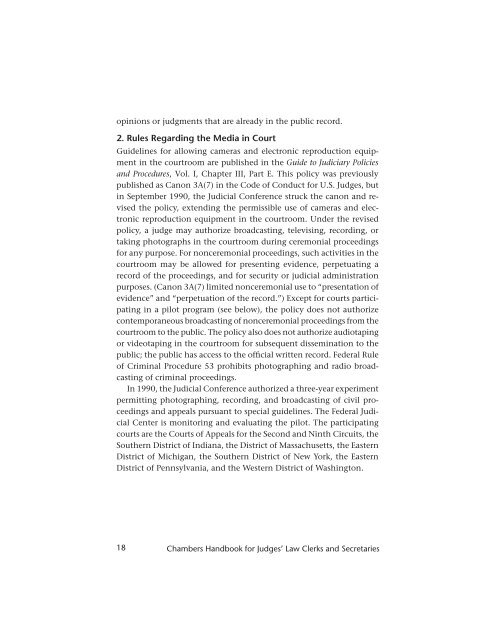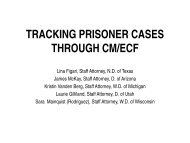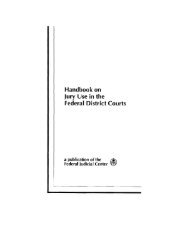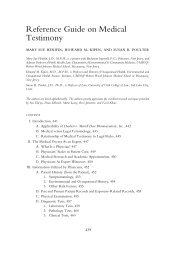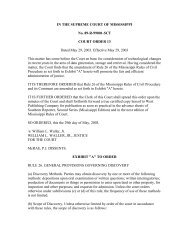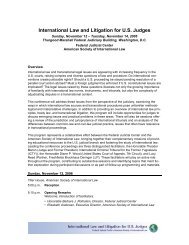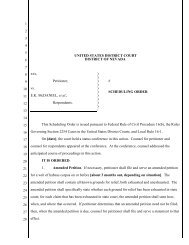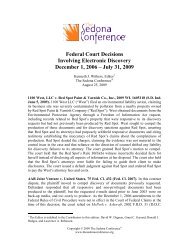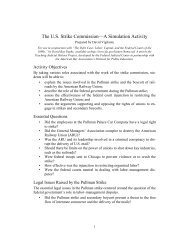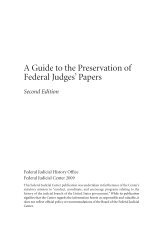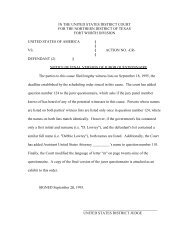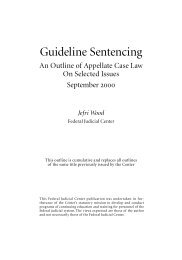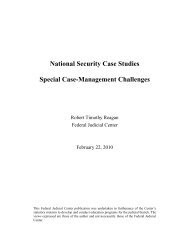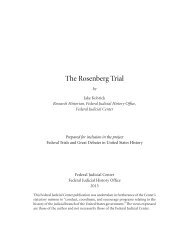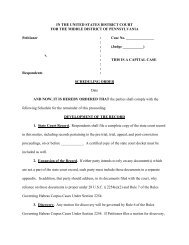Chambers Handbook for Judges - Federal Judicial Center
Chambers Handbook for Judges - Federal Judicial Center
Chambers Handbook for Judges - Federal Judicial Center
Create successful ePaper yourself
Turn your PDF publications into a flip-book with our unique Google optimized e-Paper software.
opinions or judgments that are already in the public record.<br />
2. Rules Regarding the Media in Court<br />
Guidelines <strong>for</strong> allowing cameras and electronic reproduction equipment<br />
in the courtroom are published in the Guide to Judiciary Policies<br />
and Procedures, Vol. I, Chapter III, Part E. This policy was previously<br />
published as Canon 3A(7) in the Code of Conduct <strong>for</strong> U.S. <strong>Judges</strong>, but<br />
in September 1990, the <strong>Judicial</strong> Conference struck the canon and revised<br />
the policy, extending the permissible use of cameras and electronic<br />
reproduction equipment in the courtroom. Under the revised<br />
policy, a judge may authorize broadcasting, televising, recording, or<br />
taking photographs in the courtroom during ceremonial proceedings<br />
<strong>for</strong> any purpose. For nonceremonial proceedings, such activities in the<br />
courtroom may be allowed <strong>for</strong> presenting evidence, perpetuating a<br />
record of the proceedings, and <strong>for</strong> security or judicial administration<br />
purposes. (Canon 3A(7) limited nonceremonial use to “presentation of<br />
evidence” and “perpetuation of the record.”) Except <strong>for</strong> courts participating<br />
in a pilot program (see below), the policy does not authorize<br />
contemporaneous broadcasting of nonceremonial proceedings from the<br />
courtroom to the public. The policy also does not authorize audiotaping<br />
or videotaping in the courtroom <strong>for</strong> subsequent dissemination to the<br />
public; the public has access to the official written record. <strong>Federal</strong> Rule<br />
of Criminal Procedure 53 prohibits photographing and radio broadcasting<br />
of criminal proceedings.<br />
In 1990, the <strong>Judicial</strong> Conference authorized a three-year experiment<br />
permitting photographing, recording, and broadcasting of civil proceedings<br />
and appeals pursuant to special guidelines. The <strong>Federal</strong> <strong>Judicial</strong><br />
<strong>Center</strong> is monitoring and evaluating the pilot. The participating<br />
courts are the Courts of Appeals <strong>for</strong> the Second and Ninth Circuits, the<br />
Southern District of Indiana, the District of Massachusetts, the Eastern<br />
District of Michigan, the Southern District of New York, the Eastern<br />
District of Pennsylvania, and the Western District of Washington.<br />
18 <strong>Chambers</strong> <strong>Handbook</strong> <strong>for</strong> <strong>Judges</strong>’ Law Clerks and Secretaries


